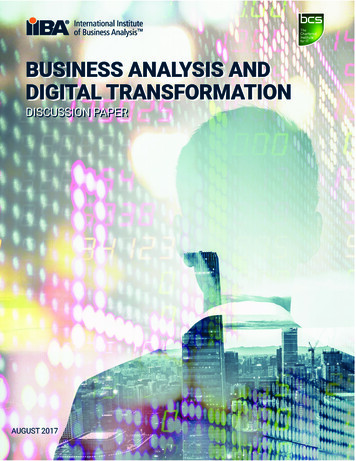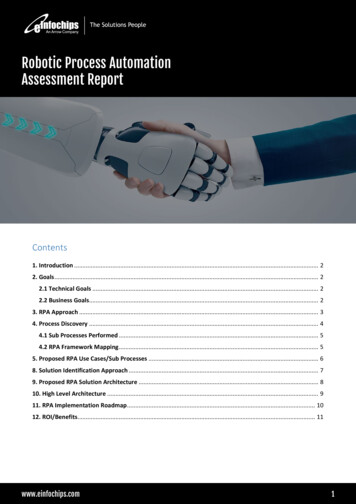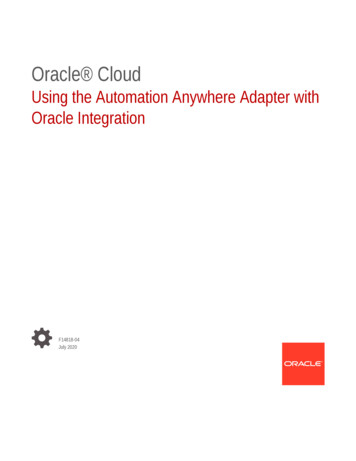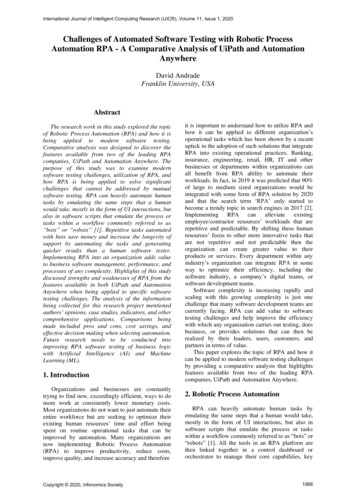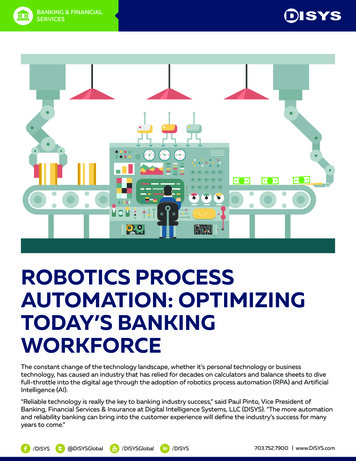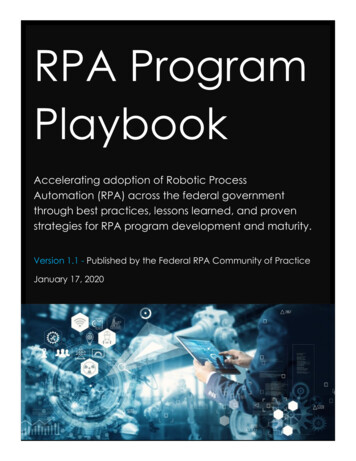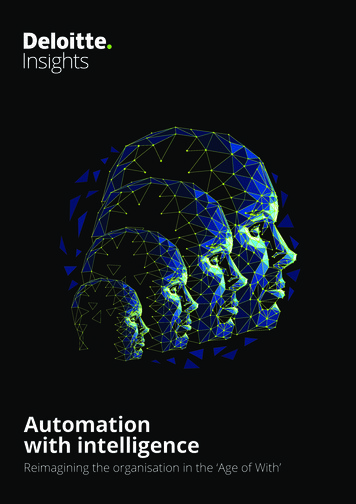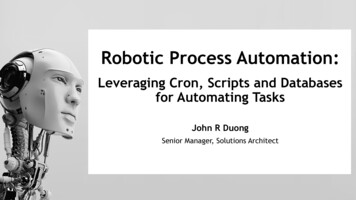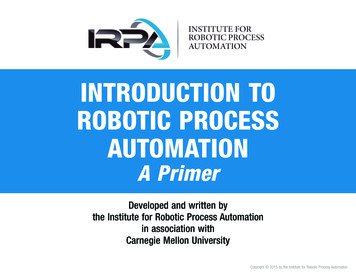
Transcription
INTRODUCTION TOROBOTIC PROCESSAUTOMATIONA PrimerDeveloped and written bythe Institute for Robotic Process Automationin association withCarnegie Mellon UniversityCopyright 2015 by the Institute for Robotic Process Automation
CONTENTSA Message from IRPA Founder Frank Casale: Hard Facts and HypeThe Data and the Drama Behind Robotic Process Automation . . . . . . . . . . . . . . . . . . . . 02. . . . . . . . . . . . . . . . . . . . . . . 051Beyond Pressing a Button: The Automation of Automation2From Transactional to Analytical: The Upsides of Robotic Process Automation . . . . . . 093The End of Outsourcing? The Call for a New Synergy . . . . . . . . . . . . . . . . . . . . . . . . . . . . 174Welcome to the Future: Robotic Process Automation Is Here to Stay . . . . . . . . . . . . . . 215Revving to Go: The Roadmap to RPA Success . . . . . . . . . . . . . . . . . . . . . . . . . . . . . . . . . . . 256In Review: What to Take Away from RPA. . . . . . . . . . . . . . . . . . . . . . . . . . . . . . . . . . . . . . . 28Join Our Network: Stay Informed and Keep Connected. . . . . . . . . . . . . . . . . . . . . . . . . . 30References . . . . . . . . . . . . . . . . . . . . . . . . . . . . . . . . . . . . . . . . . . . . . . . . . . . . . . . . . . . . . . . . . . 33Acknowledgments . . . . . . . . . . . . . . . . . . . . . . . . . . . . . . . . . . . . . . . . . . . . . . . . . . . . . . . . . . . 341Copyright 2015 by the Institute for Robotic Process Automation
A MESSAGE FROM IRPA FOUNDERFRANK CASALEHARD FACTS AND HYPEThe Data and the DramaBehind Robotic Process AutomationImagine a world in which the meaning of “work” has been redefined for millions of people. Where ourservice economy can actually focus on providing services, delivered by an engaged talent pool that isinnovating on such service. In this new world, work would no longer be a “four-letter word” associated withfunctioning within repeatable systems and mundane transactional processes. Instead, this other world wouldhave workers who rethink end-to-end processes on a more holistic level with the goal of simultaneouslyimpacting several factors: quality, compliance, functionality, best practices, regulatory functions, customersatisfaction, human error, and the all-important bottom line – all while continuing to create “the next” inthe form of remarkable products and services.If you’ve come to this book, it’s probably because someone you know has told you that, in fact, this isthe world we are already living in – that 2015 is to robotic process automation (RPA) what 1994 was tothe Internet – an auspicious start, but we ain’t seen nothing yet! Thanks to RPA, we are well on our way todoing the business of the future. However, none of us can really predict just how revolutionary it will be.2Copyright 2015 by the Institute for Robotic Process Automation
HARD FACTS AND HYPE: THE DATA AND THE DRAMA BEHIND ROBOTIC PROCESS AUTOMATIONThe mere mention of robots could conjure the worst nightmare of anyone who has read Aldous Huxleyor watched “The Matrix,” but science fiction’s prediction that robots will become smarter than humans andmake them obsolete has no place here. There’s a lot of hype and paranoia regarding what RPA is capableof, now and in the future, and what it will mean for labor arbitrage. As Founder and CEO of The OutsourcingInstitute, I feel like this is déjà vu all over again. In the early 1990s, I sensed that outsourcing was going to“And as we look tobe more than a passing trend, and despite its controversy, it became a pivotal strategy for companies seekinghistory to help usaccess to world-class capabilities and much-needed cost reductions. Outsourcing’s ability to have such apredict the future,dramatic impact on cost reduction would make implementation for most organizations a no-brainer. It waswe cannot denyapparent that as outsourcing grew, labor pools, locally and globally, would be impacted. Some peoplethat automation;panicked, others were enraged, but no matter, the macro and micro economic effect was historical – yes,in particular, roboticcontroversial – yes, political – yes, stoppable – no.process automationAnd as we look to history to help us predict the future, we cannot deny that automation, in particularis today’s versionrobotic process automation, is today’s version of outsourcing – unstoppable. And as industry leaders andof outsourcing –employees across all domains begin to run scared, there are many of us who are optimistic about the futureunstoppable.”of work: there will always be work, just a very different kind. As human beings live longer and retire later, itmakes sense to work with RPA not necessarily to put workers on the unemployment line, but to retrain themin ways that makes sense for what we are capable of creating and producing in the 21st century. By lookingto the future of work through the RPA lens, we can predict what kind of education, skills, and domains ourchildren should be committing to and preparing for what is inevitable – robotic process automation is hereto stay. In fact, there’s no denying that automation has been in our zeitgeist for quite some time – from theautomated money counter that eliminated the bank teller’s error in cashing your check to the food choicesavailable to you on an airline’s menu to the locations programmed in the GPS of your car, automation is notnew, but ever-evolving.3Copyright 2015 by the Institute for Robotic Process Automation
HARD FACTS AND HYPE: THE DATA AND THE DRAMA BEHIND ROBOTIC PROCESS AUTOMATIONWill there be job casualties along the way? Absolutely. But the fact is, those companies that bury theirheads in the sand and don’t make the pivot, either because they don’t want to or don’t know how to, willsuffer the same fate as the companies that just two decades ago didn’t prepare for the shift to anoffshore/outsourcing economy.This primer has been written to help you become informed on how you might prepare to make the pivot,to understand better what RPA does and will do in the future, and learn how it can affect the redesign of“The benefits ofprocesses and increase quality and value while decreasing costs.digital labor areMaking the pivot to RPA is a decisive moment for service providers. The benefits of digital labor arerapidly eclipsing therapidly eclipsing the benefits of physical labor, and service providers can choose or decline to translate thatbenefits of physicalinto success. I forecast that by 2020 as much as 40 percent of information technology outsourcing (ITO)labor, and serviceand business process outsourcing (BPO) service providers will be out of business or acquired by largerproviders canenterprises, if they fail to embrace the change and reinvent their business models.choose or declineFor the buyer community, RPA is appealing because it is quick and cost effective and doesn’t sendto translate thatjobs offshore. It is my hope that our work at the Institute for Robotic Process Automation (IRPA), alonginto success.”with the information in this primer, will help business leaders on both the buyer and service sides positionthemselves at the cutting-edge of knowledge work technology, turning what they thought was a dystopic“humans need not apply” ending into a utopic beginning for the future of work.email: salehttps://www.linkedin.com/in/fcasale4Copyright 2015 by the Institute for Robotic Process Automation
1Beyond Pressing a ButtonThe Automation of AutomationLabor automation is anything but new. But what does automation 2.0 look like? What is the differencebetween what we’ve seen robotically replace the work typically performed by human beings and roboticprocess automation (RPA)? While we typically think of traditional automation in terms of assembly linethe automationindustry, robotictechnology, ATMs, automated toll booths, and self-checkout counters, robotic process automationprocess automationdeals with “smart software” and the application of smart software to do high-volume, repeatable tasks thatis perceived asusually take humans an unbearable length of time to accomplish and which they typically find mundaneoffering uniqueto perform.capabilities andOne of the debates surrounding RPA revolves around the question of whether this technology is trulyadvantagesrevolutionary or simply the product of the evolution of other similar technologies. Many technologies,over previousincluding artificial intelligence (AI), expert systems, and other methods of process automation have servedtechnologies.”as predecessors to RPA. That being said, RPA takes artificial intelligence and expert systems to an elevatedlevel. Among leaders in the automation industry, robotic process automation is perceived as offering uniquecapabilities and advantages over previous technologies.15Copyright 2015 by the Institute for Robotic Process Automation“Among leaders in
BEYOND PRESSING A BUTTON: THE AUTOMATION OF AUTOMATIONThe Evolution ofAutomationWhat’s So Great About What We Automate?“Autonomics,” as IBM, and other organizations call it, gives any work process that is definable, repeatable,and rules-based the ability to map out a business process and assign a software robot to manage theexecution of that process, just as a human would. RPA technology is not a part of a company’s informationtechnology infrastructure, but rather sits on top of it.2 This allows a company to implement the technology6Copyright 2015 by the Institute for Robotic Process Automation
BEYOND PRESSING A BUTTON: THE AUTOMATION OF AUTOMATIONquickly and efficiently without altering existing infrastructure and systems. Another way to look at RPAtechnology is to consider that it is not designed to be a business application, but designed to be a proxyfor a human worker to operate business applications.3When a bank in the United Kingdom needed a strategy to deal with its increase in high-risk accounts,robotic process automation was an attractive alternative because the technology allows a business process“The automationto be automated without changing existing company systems and framework. There are a number of high-risksoftware reduced thecustomer accounts that must be reviewed daily, and these customers are listed in this “queue” because theybank’s processinghave insufficient funds to cover scheduled and upcoming payments. Prior to the automation of this system, acosts by 80 percent.team of eleven employees was assigned to clear this queue daily – approximately 2,500 accounts requiredThe automation hasmanual review to determine whether or not the payments should be processed or returned. It took up to eightfreed the bank’shours for these eleven employees to reach the end of the queue, and the risk of inconsistency and error wasemployees from dullalways present.and tedious tasks,In hopes of improving the efficiency of the queue review process, the bank began to explore other options.thereby enablingIt worked with a robotic process automation provider to implement an automation procedure within a fewthem to be moreshort months. This new procedure employs twenty virtual robotic employees that complete the queue reviewproactive in theirprocess exactly as a human would. With the implementation of this new software, the efficiency and accuracyrelationships withof the process have increased dramatically.customers.”Now, the same task that typically took eleven employees until 3 pm to finish is complete by 11 am. Theautomation software reduced the bank’s processing costs by 80 percent. The automation has freed the bank’semployees from dull and tedious tasks, thereby enabling them to be more proactive in their relationships withcustomers. Customer service practices have improved and customer relationships strengthened. The bankhas been extremely pleased with the results of this RPA implementation and continues to analyze its businessprocesses and functions for additional automation opportunities.47Copyright 2015 by the Institute for Robotic Process Automation
BEYOND PRESSING A BUTTON: THE AUTOMATION OF AUTOMATIONWhile traditional automation can complete a rules-based, repeatable task, RPA takes automation a step“Dubbed thefurther. Dubbed the “automation of automation,” RPA combines automation with the adaptability and‘automation ofawareness of artificial intelligence. This technology is able to learn and respond to problems that would haveautomation,’ RPAstumped traditional automation software. With adaptability and awareness, RPA is capable of automatingcombines automationactivities that once required human judgment. These software robots are able to perform the tasks ofwith the adaptabilityknowledge workers whose jobs have (up until recently) been immune to the impacts of automation.and awareness ofartificial intelligence.”“WiTh AdApTAbiliTy And AWArEnEss,rpA is cApAblE of AuTomATing AcTiviTiEsThAT oncE rEquirEd humAn judgmEnT.”The difference between RPA and traditional business process automation could be likened to a driverlessrobotic car versus a car using cruise control. Cruise control simply modulates vehicle speed, while the“The differencedriverless car is able to be aware, learn, adapt, and respond to various driving situations, as a human would.between RPA andThis adaptability and awareness is what gives RPA the edge over traditional business and informationtraditional businesstechnology process automation technology.5process automationAwareness becomes a key characteristic of robotic process automation through the ability to conductcould be likened to acustomer analytics, data mining, social media analysis, and the warehousing of big data, just like e-tailerdriverless robotic carAmazon works to further understand the behaviors, habits, and needs of its customers. As companiesversus a car usingtransition to robotic process automation, they will aggressively re-engineer themselves with these smartcruise control.”systems, thereby reducing the need for remote labor pools. They’ll also improve business processes andexecute sophisticated and targeted data analytics with increased speed, quality, and scalability.8Copyright 2015 by the Institute for Robotic Process Automation
2From Transactional to AnalyticalThe Upsides of Robotic Process AutomationWhen Laura, who works in the purchasing department for a regional auto parts chain, began workingwith automated technology, she no longer had to spend her time doing manual inventory counts,submitting purchase requisitions, and processing credit verification, which saved her hours of paperworkand potential processing delays. But here’s how RPA takes on a more analytical role than a transactional one:when inventory count is low, the software can be trained to trigger the issuance of a purchase requisition“The sophisticatedfrom the appropriate department. The sophisticated system even has the ability to interface with vendorsystem even hassystems to verify the availability of the inventory items that are needed. Finally, once requisitions are verified,the ability to inter-purchase orders can be sent out by the system. And all of this is done automatically, without the need forface with vendorLaura’s involvement.systems to verifythe availability ofthe inventory itemsDecreased Operational Coststhat are needed.”In the last couple of decades, offshoring and outsourcing have become popular business tactics for decreasingoperating costs. Labor in the United States is much more expensive than labor in the Philippines or India, forexample. From 2000 to 2010, it was reported that U.S. multinational firms hired nearly 2.4 million offshore9Copyright 2015 by the Institute for Robotic Process Automation
FROM TRANSACTIONAL TO ANALYTICAL: THE UPSIDES OF ROBOTIC PROCESS AUTOMATIONemployees and cut 2.9 million jobs in the United States.6 Offshore has its costs, but the costs are not nearlyas high as payroll within the United States. Remarkably, RPA technology has proven to cut the cost of anoffshore full-time employee (FTE) in half.6follow the costsaveRobotic process automation is creating a “shift beyond labor arbitrage,” or ShiBLA as I refer to it, and isreducing labor costs by 25 to 40 percent in both IT and business process environments.While many companies, large and small, will find RPA decreases their need for human labor, diminishesprocessing times, and ignites the ability to easily interface with foreign systems valuable to their bottomlines, there are many other benefits of RPA. For instance, RPA changes the rules of the game by allowingorganizations to continually monitor business or IT processes and the behavior of personnel and softwareapplications as part of those processes. That monitoring of patterns and events is performed by virtualengineers (robots) that can actually learn by observing process-based activities undertaken by humanengineers. The subsequent knowledge gathered through machine observation can then be incorporatedinto future computer inferences made during operations. Not only can RPA be used to identify an anomaly,10Copyright 2015 by the Institute for Robotic Process Automation
FROM TRANSACTIONAL TO ANALYTICAL: THE UPSIDES OF ROBOTIC PROCESS AUTOMATIONthereby turning workers into problem solvers, it can also initiate a set of action items to respond to theoccurrence.A globally recognized insurance firm in the United States was in the process of transitioning its data andsystems to a private cloud infrastructure. This infrastructure needed to have the capability to scale virtualmachines up and down as needed. The existing system that deployed and managed these virtual machines“It quickly becamewas highly reliant on human assistance. It quickly became apparent that a more autonomic (self-learning,apparent that a moreself-healing) system was required to support the company’s expanding infrastructure.autonomic (self-The solution combined virtualization technology with autonomics to craft a flexible system that is capablelearning, self-healing)of scaling up or down by thousands of virtual machines on a daily or even hourly basis. Not only are thesystem was requiredvirtual machines auto-deployed, they are self-monitoring. Even the backup management has been automated.to support theThis greatly reduces the amount of human intervention required while also eliminating errors during thecompany’s expandingprocess.infrastructure.”The insurance company was able to implement this solution in three office locations within 120 days,allowing them to make the transition to the new infrastructure twelve months sooner than expected. Thisunique solution has enabled the insurer to guarantee 99.99 percent availability of its critical systems.7Improved Data AnalyticsEach task the robot executes produces data that, when gathered, allows for an analysis. This drives betterdecision making in the areas of the processes being automated. When data is efficiently combined, compared,and contrasted to data collected in other areas, it allows for better decision making on both a micro andmacro level. As each step in a process is traced, a company is able to identify gaps where processes couldbe further optimized to increase efficiency.11Copyright 2015 by the Institute for Robotic Process Automation
FROM TRANSACTIONAL TO ANALYTICAL: THE UPSIDES OF ROBOTIC PROCESS AUTOMATIONIncreased Regulatory ComplianceThe nature of automation means that each step in an IT or business process is fully tracked and documented“As software robotswithin the system that is being automated. This makes a company become more compliant with industryhandle the moreand audit regulations. RPA is a lifesaver for industries that have functional areas highly regulated by strictrepetitive, tediouscompliance guidelines, such as healthcare, banking, and insurance. In an RPA-enabled scenario, the solutionsjobs in a business,will provide in-depth telemetry/data about workflow, thus enabling tremendous insight and documentation toemployees cancomply with specific regulations.participate in morevalue-addedactivities that involveIncreased Efficiencypersonal interaction,A software robot never needs time off – it can work twenty-four hours a day, seven days a week, and 365problem solving, anddays a year. It doesn’t call in sick or take a vacation. Typically, a single software robot can replace two to fivedecision making.”full-time employees, possibly more. The same volume of work can be done in less time, or more volume canbe processed in the same amount of time, thereby allowing downstream work to commence sooner.Higher Employee ProductivityAs software robots handle the more repetitive, tedious jobs in a business, employees can participate in morevalue-added activities that involve personal interaction, problem solving, and decision making. Robotic processautomation allows employees to complete tasks that are more valuable to the company and its customers.When employees feel their work is valued and worthwhile, their productivity increases, which increases12Copyright 2015 by the Institute for Robotic Process Automation
FROM TRANSACTIONAL TO ANALYTICAL: THE UPSIDES OF ROBOTIC PROCESS AUTOMATIONemployee retention rates. But beyond being able to participate in more value-added activities, employees arebetter supported for their value-added tasks. This can help increase productivity. Again, the same volume ofwork can be done in less time, thereby allowing downstream work to commence sooner.Improved Accuracy“As employees moveEmployees are human, and all humans make mistakes. A compelling feature of RPA is its capability to virtuallyto more customer-eliminate processing errors. It’s not a turn-key solution. There will still be the need for testing, training, andfacing roles, and asgovernance, but as long as a process is properly optimized and all its sub-processes are accurately mapped,automation makesa business need not worry that its software robots will make the mistakes that its employees might.processes moreefficient and errorfree, customers areIncreased Customer Satisfactionlikely to becomemore satisfied withAs employees move to more customer-facing roles, and as automation makes processes more efficient andtheir experience.”error-free, customers are likely to become more satisfied with their experience. As a company improves itsrelationships with its customers, customer satisfaction, retention, and acquisition will improve as well.Logistical UpsideTransitioning to RPA will minimize or eliminate complications with offshore labor as it relates to time zonedifferences and cultural and language barriers. Using RPA can also decrease the need for employeerecruitment and training costs.13Copyright 2015 by the Institute for Robotic Process Automation
FROM TRANSACTIONAL TO ANALYTICAL: THE UPSIDES OF ROBOTIC PROCESS AUTOMATIONRPA and Business Processes“Process automationcan expedite back-Technologies like presentation-layer automation software – a technology that mimics the steps of a rules-office tasks inbased, non-subjective process without compromising the existing IT architecture – are able to consistentlyinsurance, finance,carry out prescribed functions and easily scale up or down to meet demand. Process automation canprocurement, supplyexpedite back-office tasks in insurance, finance, procurement, supply chain management, accounting,chain management,customer service, and human resources. It could also perform duties including data entry, placing purchaseaccounting, customerorders, creating online access credentials, and completing business processes that require “swivel-chair”service, and humanaccess to multiple existing systems.resources.”IT Support and ManagementAutomated processes in the remote management of IT infrastructures can consistently investigate and solve“Separatingproblems for faster process throughput. Robotic process automation can improve service desk operationsscalability fromand the monitoring of network devices. Separating scalability from human resources allows a company tohuman resourceshandle short-term demand without extra recruiting or training. Additionally, IT management will be moreallows a companyto handle short-termeffective because RPA makes it easy to maintain a scalable infrastructure. In short, it’s easier to scaledemand withoutsoftware than it is people.extra recruitingor training.”“rpA Works WEll in Any indusTryWiTh dEfinAblE, rEpEATAblE,And rulEs-bAsEd procEssEs.”14Copyright 2015 by the Institute for Robotic Process Automation
FROM TRANSACTIONAL TO ANALYTICAL: THE UPSIDES OF ROBOTIC PROCESS AUTOMATIONRPA VersatilityOne of the most powerful benefits of RPA technology is the scope of its usability across various industries“One of the mostand its ability to complete a variety of tasks. For a particular task to be a good candidate for automation bypowerful benefitsRPA, it must be definable, repeatable, and rules-based. Once these conditions have been met, the software’sof RPA technologyflexibility allows companies to be creative in the tasks they choose to automate. These tasks might includeis the scope of itsclosing and opening accounts, completing requests for proposals, handling various processes in the billingusability acrossand customer service departments, or IT systems testing and monitoring.various industriesWhile RPA works well in any industry with definable, repeatable, and rules-based processes, certainand its ability toindustries are more compatible for the technology, such as healthcare, banking, and insurance industries,complete a varietybecause they all dedicate significant numbers of labor hours to the tasks that could be handled by softwareof tasks.”robots. Robotic process automation can excel at operating multi-step tasks across multiple systems including,but not limited to, the following: fraud chargeback processing internet application processing low-risk arrears review business account audit requests medium-risk arrears review business account onboarding direct debit cancellations excess transaction approvals personal account closures excess check approvals payment processing excess customer letters15Copyright 2015 by the Institute for Robotic Process Automation
FROM TRANSACTIONAL TO ANALYTICAL: THE UPSIDES OF ROBOTIC PROCESS AUTOMATION amend standing order details data cleansing amend direct debit details payment protection insurance claims amend address details transaction duplication right of set off automated fraudulent account closureprocess automated branch risk monitoringprocessprocessing“For a particular automation of the administration oftask to be a goodpayment termscandidate for automated support for sale of insuranceautomation by RPA,productsit must be definable,repeatable, and automated marketing campaignsrules-based.” customer complaints automation personal loan application opening compliance reporting automation new loan product blitz insurance product administrationautomation16Copyright 2015 by the Institute for Robotic Process Automation
3The End of Outsourcing?A Call for a New SynergyThe University Hospital Birmingham (UHB) National Health Service Foundation Trust implemented RPAtechnology to reduce the time it took to register patients. The goal of the project was to create anefficient, easy, and intuitive patient registration process through the implementation of registration kiosks.“More than half of allThese kiosks needed to be able to access the National Program of IT Patient Administration System (NPfITpatients registeredor PAS) in accordance with the NPfIT security policy. This system would also need to be operational withinwith these kiosks,a very short timescale in advance of the opening of a new hospital.patient flow movedAs the Trust explored different options for system operation, it realized that traditional IT approacheswould require deep access to the PAS and would not be in accordance with the NPfIT security policy. Roboticprocess automation technology, however, had the ability (without this deep connection) to access the systemrapidly while staying in accordance with the security policy – and did so within the required timeframe.twice as quickly,and staff became50 percent moreAs the patient registration kiosks were implemented at the hospital, the results were positive. More thanefficient.”half of all patients registered with these kiosks, patient flow moved through reception twice as quickly, andstaff became 50 percent more efficient. Patients reported high satisfaction with the kiosks, noting that theywere fast and easy to use.817Copyright 2015 by the Institute for Robotic Process Automationthrough reception
THE END OF OUTSOURCING? A CALL FOR A NEW SYNERGYThese patient registration kiosks turned out to be just a starting point for robotics process automation atUniversity Hospitals Birmingham. After the success with utilizing RPA technology with the kiosks, the hospitalbegan to apply it to other business processes. The hospital created an RPA system to keep the “PatientMaster Index” current. Through this process the UHB was able to automatically cancel appointments forrecently deceased patients, keeping the hospital from unnecessarily holding spots and making potentiallyupsetting appointment reminders. Some of the other processes automated by the hospital include pharmacystock control updates, outpatient appointment outcomes, job transfer data, and system monitoring.9What I’ve observed time and again is the company that employs robotic automation quickly gains a“What I’ve observedcompetitive advantage. Whether it is used to create a virtual back office, an IT infrastructure, or to do anytime and again istype of work that is definable, repeatable, and rules-based, digital labor hikes efficiency, improves data assetsthe company thatfrom advanced analytics, and causes a dramatic uptick in operational speed and performance. Additionally,employs roboticthose who embrace digital labor will yi
robotic process automation was an attractive alternative because the technology allows a business process to be automated without changing existing company systems and framework. There are a number of high-risk customer accounts that must be reviewed daily, and these customers are listed in this “queue” because they .

